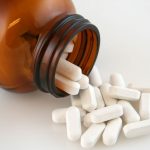
Glutamine (L-glutamine) is recognised as a very important ingredient, an amino acid, in the supplement armoury for the serious body builder and athlete. Whilst we can synthesise this amino-acid which means it is non-essential, it is slow to be replaced by natural means and so supplementation is a serious prospect for those involved in very intense exercise. The main dietary sources are fish and other high protein foods.
One of the main reasons for its impact is that it forms up to 60% of amino-acids in skeletal muscle. It is synthesised mainly in muscle and serves a regulatory role in the nitrogen balance of the body. It is also viewed as a major source of nitrogen for building muscle cells by being the principal transporter of this element into this type of tissue.
It’s been observed that glutamine is readily depleted in the body following bouts of intense exercise and is not readily replaced without supplementation. Loss of glutamine means a decrease in stamina, strength and poor recovery because of its involvement in transport processes across cell membranes as well as forming a structural component in muscle tissue. Without supplementation, it is claimed to take up to 6 days for its levels to return to normal. L-glutamine supplementation helps to reduce breakdown in muscle and improve protein metabolism.
What Forms Of Glutamine Are Available
Supplements are available in powder or capsule form. The powder form is often preferred by customers because the dosage is bigger in one small scoop compared to a few capsules. When mixed with liquids, glutamine powder is virtually tasteless.
There are two types of glutamine supplements—glutamine peptides and L-glutamine. L-glutamine is a “free form” and not bonded to other amino acids. Most supplement takers prefer glutamine peptides, which is this amino acid bonded to other types of amino acids. These are more stable and better absorbed and assimilated by the body. However, most studies showing the benefits of glutamine supplements use the free form and not peptides.
Glutamine Peptides
They are taken by athletes due to their higher bioavailability, with research suggesting that the body can utilize glutamine far quicker in this format.
How Much To Take
Most suppliers provide the raw form, suggesting about 5 grams per day is optimal, 1 to 3 times daily and consumed with water or fruit juice. Times to supplement are at breakfast, lunch and an hour before sleeping. The amount ingested does depend on body weight. Glutamine supplementation is not recommended for those mainly with neurological diseases, stroke or pregnancy because of the conversion of L-glutamine to L-glutamate which is an excitotoxin.
For those looking to take glutamine for developing their muscle mass, adults should avoid ingesting more than 40 grams per day. The benefits of glutamine still remain to be scientifically evaluated which may seem contradictory in the light of its metabolic importance, and so must be carefully considered when used as part of a nutritional plan, especially when increasing muscle mass.
Energy Expenditure, Fitness And Immunity
One of the main roles for L-glutamine in the body is to help us detoxify blood and tissues by cleansing the body of high levels of ammonia. This is produced as a result of general protein metabolism. Glutamine acts as a buffer and converts excess ammonia into other amino acids, amino sugars and urea (Shen et al., 1998).
Roughly speaking, about one hour of exercise produces a 40 percent loss of glutamine from the body. Such a loss can produce a suppressed immune function. This has a negative impact on the degree of resistance training and may lead to the often troubling situation of overtraining syndrome.
Glutamine’s Role In Sustaining The Immune System
L-glutamine helps all of us with supporting our immune system. It is a fuel molecule for various cells especially immune cells, white blood cells and some that are found in the intestine. The particular cells in the immune system called T-helper cells benefit most from this amino acid.
Animal studies have indicated that this increase in T-helper cells may reduce certain types of physical stress associated with overtraining syndrome (Chue et al., 2012).
High glutamine diets, supplementation with the amino acid and even high protein diets have been prescribed for patients who have suffered severe burns (de Souza & Greene, 1998).
Liver Diseases
L-glutamine supplementation may also be helpful in the treatment of Non-Alcoholic Fatty Acid Disease (NAFLD) and the second stage of this called NASH (Non-Alcoholic Steatohepatitis). At the moment, pharmacological dosing might help although this improvement has only recently been shown with mice (Sellmann et al., 2017).
References
de Souza, D.A., Greene, L.J. (1998) Pharmacological nutrition after burn injury. J. Nutr. 128(5) pp. 797-803 (Article)
Sellmann, C., Baumann, A., Brandt, A., Jin, C.J., Nier, A. Bergheim, I. (2017) Oral Supplementation of Glutamine Attenuates the Progression of Nonalcoholic Steatohepatitis in C57BL/6J Mice. J. Nutr. 147(11) pp. 2041-2049 DOI: 10.3945/jn.117.253815



Leave a Reply